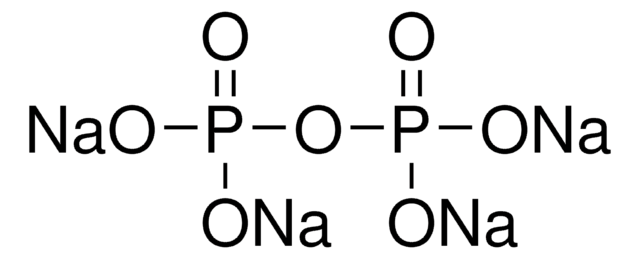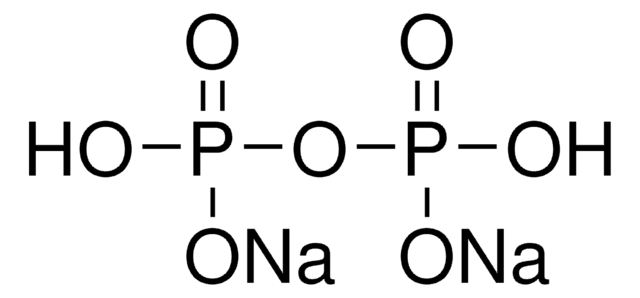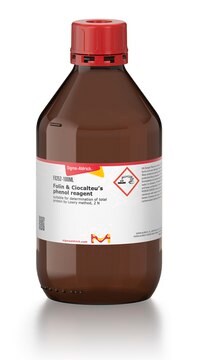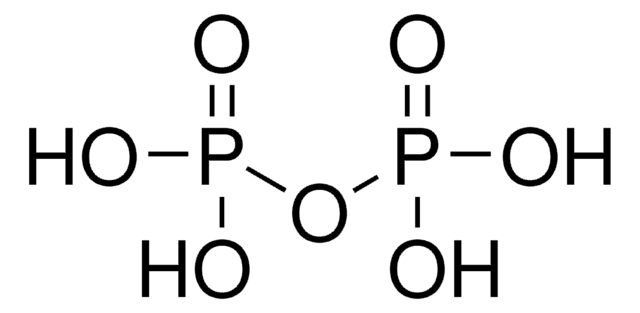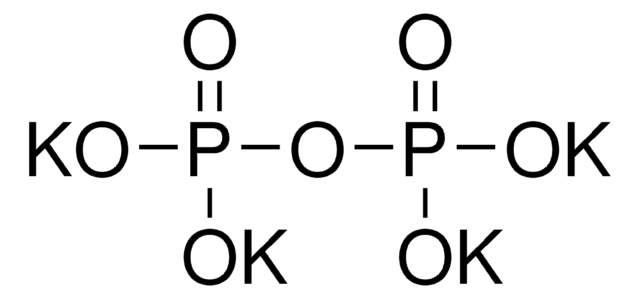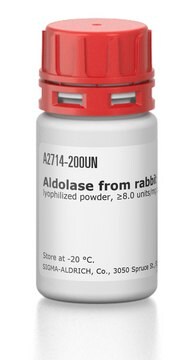P7275
Pyrophosphate reagent
spectrophotometric assay
Synonym(s):
Pyrophosphate detection reagent
Sign Into View Organizational & Contract Pricing
All Photos(1)
About This Item
UNSPSC Code:
12352204
NACRES:
NA.54
Recommended Products
Related Categories
Application
The product has been used for the measurement of pyrophosphate content of plant tissues. It has also been used as a rapid, routine check of pyrophosphate content by monitoring NADH oxidation in Solanum tuberosum tuber extracts.
Biochem/physiol Actions
The pyrophosphate detection kit couples the production of pyrophosphate to the consumption of NADH.
Packaging
A technical bulletin is included.
Components
ComponentConcentration
Imidazole × HCl, pH 7.4 45 mM
Citrate 5 mM
EDTA 0.10 mM
Mg2+, Mn2+, Co2+ 2 mM, 0.2 mM, 0.02 mM
β-NADH 0.8 mM
F-6-P 12 mM
Bovine Serum Albumin 5 mg/mL
Sugar Stabilizer 5 mg/mL
PPi-PFK 0.5 units/mL
Aldolase 7.5 units/mL
GDH 5 units/mL
TPI 50 units/mL
Imidazole × HCl, pH 7.4 45 mM
Citrate 5 mM
EDTA 0.10 mM
Mg2+, Mn2+, Co2+ 2 mM, 0.2 mM, 0.02 mM
β-NADH 0.8 mM
F-6-P 12 mM
Bovine Serum Albumin 5 mg/mL
Sugar Stabilizer 5 mg/mL
PPi-PFK 0.5 units/mL
Aldolase 7.5 units/mL
GDH 5 units/mL
TPI 50 units/mL
Quality
A coupled enzyme system containing fructose-6-phosphate kinase (pyrophosphate-dependent), aldolase, triosephosphate isomerase, and α-glycerophosphate dehydrogenase.
Principle
Two moles of NADH are oxidized to NAD+ per mole of pyrophosphate consumed. The reaction is monitored spectrophotometrically at 340 nm.
The reagent can be used to detect 10-100 nmoles of pyrophosphate.
The reagent can be used to detect 10-100 nmoles of pyrophosphate.
Preparation Note
Dissolve the contents of one vial of Pyrophosphate Reagent in 4.0 mL of water.
Storage Class Code
11 - Combustible Solids
WGK
WGK 3
Flash Point(F)
Not applicable
Flash Point(C)
Not applicable
Personal Protective Equipment
dust mask type N95 (US), Eyeshields, Gloves
Choose from one of the most recent versions:
Already Own This Product?
Find documentation for the products that you have recently purchased in the Document Library.
Customers Also Viewed
Devin W Cochrane et al.
Plant science : an international journal of experimental plant biology, 265, 124-130 (2017-12-11)
Class 1 plant hemoglobins (phytoglobins) are upregulated during low-oxygen stress and participate in metabolism and cell signaling via modulation of the levels of nitric oxide (NO). We studied the effects of overexpression and knockdown of the class 1 phytoglobin gene
R Viola et al.
Plant physiology, 97(2), 638-643 (1991-10-01)
Pretreatment of discs excised from developing tubers of potato (Solanum tuberosum L.) with 10 millimolar sodium fluoride induced a transient increase in 3-phosphoglycerate content. This was followed by increases in triose-phosphate, fructose 1,6-bisphosphate and hexose-phosphate (glucose 6-phosphate + fructose 6-phosphate
Erick Strauss et al.
The Journal of biological chemistry, 277(50), 48205-48209 (2002-10-10)
Pantothenic acid (vitamin B(5)) is the natural precursor of coenzyme A (CoA), an essential cofactor in all organisms. The pantothenic acid antimetabolite N-pentylpantothenamide inhibits the growth of Escherichia coli with a minimum inhibitory concentration of 2 microm. In this study
A continuous spectrophotometric assay for argininosuccinate synthetase based on pyrophosphate formation.
W E O'Brien
Analytical biochemistry, 76(2), 423-430 (1976-12-01)
D A Smyth et al.
Plant physiology, 75(3), 862-864 (1984-07-01)
Pyrophosphate (PPi) was measured in pea (Pisum sativum L.) and corn (Zea mays L.) tissues by using an enzymic method based on PPi-dependent phosphofructokinase (PPi-PFK). Different organs of pea and corn seedlings were extracted to determine if PPi is present
Our team of scientists has experience in all areas of research including Life Science, Material Science, Chemical Synthesis, Chromatography, Analytical and many others.
Contact Technical Service
